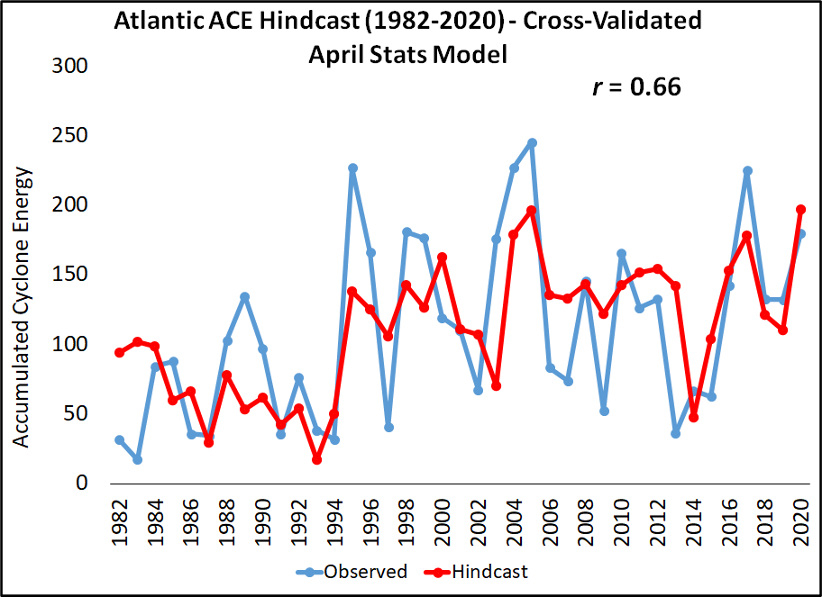Researchers predicting above-average 2021 Atlantic hurricane season
(2021-04-07) -- written by Phil Klotzbach
Colorado State University hurricane researchers are predicting an above-average Atlantic hurricane season in 2021, citing the likely absence of El Niño as a primary factor. Tropical Atlantic sea surface temperatures are near their long-term averages, while subtropical Atlantic sea surface temperatures are much warmer than their long-term average values. The warmer subtropical Atlantic also favors an active 2021 Atlantic hurricane season.
Note to reporters: You can get the PDF directly.

The tropical Pacific currently has weak La Niña conditions, that is, water temperatures are somewhat cooler than normal in the eastern and central tropical Pacific. While these waters may warm slightly during the next few months, CSU does not currently anticipate El Niño for the peak of the Atlantic hurricane season. El Niño tends to increase upper-level westerly winds across the Caribbean into the tropical Atlantic, tearing apart hurricanes as they try to form.
While the tropical Atlantic currently has water temperatures near their long-term averages, the warmer-than-normal subtropical Atlantic typically forces a weaker subtropical high and associated weaker winds blowing across the tropical Atlantic. These conditions then lead to warmer waters in the tropical Atlantic for the peak of the Atlantic hurricane season.
17 named storms
The CSU Tropical Meteorology Project team is predicting 17 named storms during the Atlantic hurricane season, which runs from June 1 to November 30. Of those, researchers expect eight to become hurricanes and four to reach major hurricane strength (Saffir/Simpson category 3-4-5) with sustained winds of 111 miles per hour or greater.
The team bases its forecasts on a statistical model, as well as a model that uses a combination of statistical information and model output from the European Centre for Medium-Range Weather Forecasts. These models are 40 years of historical hurricane seasons and evaluate conditions including: Atlantic sea surface temperatures, sea level pressures, vertical wind shear levels (the change in wind direction and speed with height in the atmosphere), El Niño (warming of waters in the central and eastern tropical Pacific), and other factors.
So far, the 2021 hurricane season is exhibiting characteristics similar to 1996, 2001, 2008, 2011 and 2017. “All of our analog seasons had above-average Atlantic hurricane activity, with 1996 and 2017 being extremely active seasons,” said Phil Klotzbach, research scientist in the Department of Atmospheric Science and lead author of the report.
The team predicts that 2021 hurricane activity will be about 140 percent of the average season. By comparison, 2020’s hurricane activity was about 170 percent of the average season. The 2020 hurricane season had six landfalling continental US hurricanes, including Category 4 Hurricane Laura which battered southwestern Louisiana.
The CSU team will issue forecast updates on June 3, July 8 and August 5.
This is the 38th year that the CSU hurricane research team has issued an Atlantic basin seasonal hurricane forecast. The Tropical Meteorology Project team also includes Michael Bell, associate professor in the CSU Department of Atmospheric Science, and Jhordanne Jones, graduate research assistant in the same department. Bill Gray, who originated the seasonal forecasts, launched the report in 1984 and continued to author them until his death in 2016.
The CSU forecast is intended to provide a best estimate of activity in the Atlantic during the upcoming season – not an exact measure.
As always, the researchers caution coastal residents to take proper precautions.
“It takes only one storm near you to make this an active season,” Bell said.
Landfalling probability included in report
The report also includes the probability of major hurricanes making landfall:
• 69 percent for the entire U.S. coastline (average for the last century is 52 percent)
• 45 percent for the U.S. East Coast including the Florida peninsula (average for the last century is 31 percent)
• 44 percent for the Gulf Coast from the Florida panhandle westward to Brownsville (average for the last century is 30 percent)
• 58 percent for the Caribbean (average for the last century is 42 percent)
The forecast team also provides probabilities of named storms, hurricanes and major hurricanes tracking within 50 miles of each county or parish along the Gulf and US East Coast, as well as hurricane-prone coastal states, Canadian provinces and countries in Central America and the Caribbean. These probabilities for regions and countries are adjusted based on the current seasonal forecast and its projected effects on the upcoming hurricane season.
Funding for this year’s report has been provided by Interstate Restoration, Ironshore Insurance, the Insurance Information Institute, Weatherboy and a grant from the G. Unger Vetlesen Foundation.